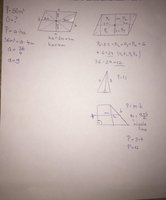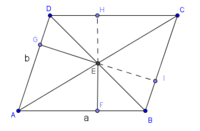Ana.stasia
Junior Member
- Joined
- Sep 28, 2020
- Messages
- 118
The question is:
The surface area of the parallelogram is 36m2. The place where the two diagonals are crossed is away from the sides 2m and 3m. What is the sum of all fours sides. I have figured out that a=9.
Here is how:

Just in case of a language barrier. P is surface area, O is the sum of all sides, h is the height. (ha is the height for the base side, hb is for the other side)
However no matter how hard I tried, I couldn't get b.
I have googled this problem and I got this:

EF=3 GE=2
HF=6, GI=4
(similar to what I did)
P=a⋅ha => 36=a⋅6 => a=6
P=b⋅hb => 36=b⋅4 => b=9
O=2⋅a+2⋅b=2⋅6+2⋅9=12+18=30
Now the result is correct. However I cannot understand how GI is hb
In school we thought that hb looks like this:

So can someone please explain to me how and why is the hb they have drawn equal to this hb or if it's not and the fact that the solution is correct is accidental. If that is the case please explain to me how I can solve it.
Thank you in advance.
The surface area of the parallelogram is 36m2. The place where the two diagonals are crossed is away from the sides 2m and 3m. What is the sum of all fours sides. I have figured out that a=9.
Here is how:

Just in case of a language barrier. P is surface area, O is the sum of all sides, h is the height. (ha is the height for the base side, hb is for the other side)
However no matter how hard I tried, I couldn't get b.
I have googled this problem and I got this:

EF=3 GE=2
HF=6, GI=4
(similar to what I did)
P=a⋅ha => 36=a⋅6 => a=6
P=b⋅hb => 36=b⋅4 => b=9
O=2⋅a+2⋅b=2⋅6+2⋅9=12+18=30
Now the result is correct. However I cannot understand how GI is hb
In school we thought that hb looks like this:

So can someone please explain to me how and why is the hb they have drawn equal to this hb or if it's not and the fact that the solution is correct is accidental. If that is the case please explain to me how I can solve it.
Thank you in advance.
